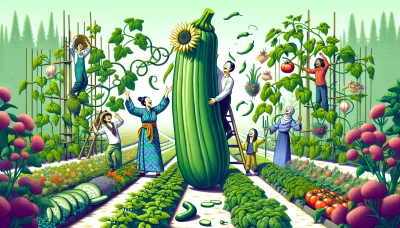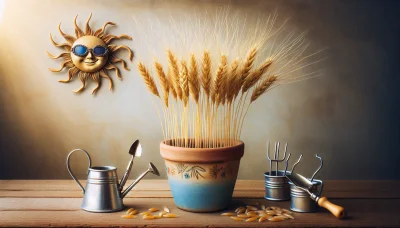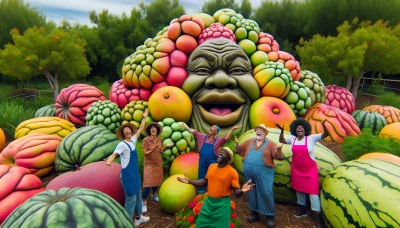Planting snap peas Quiz
Test Your Knowledge
Question of
The Ultimate Guide to Planting Snap Peas
Snap peas, a delightful and nutritious member of the legume family, are a popular choice among gardeners for several compelling reasons. These crunchy, sweet pods, fully edible when mature, offer a dual-purpose crop; they can be enjoyed both in their immature state as well as when fully grown. Snap peas thrive in cooler temperatures, making them an excellent option for early spring and late fall planting. Their relatively easy-to-grow nature and climbing habit, which adds vertical interest to gardens, make them a favorite. Moreover, snap peas are not only a treat for the taste buds but also enrich the soil by fixing nitrogen, benefiting the garden ecosystem. This guide aims to delve into the essentials of planting and enjoying your own snap peas, ensuring a bountiful and tasty harvest.
Choosing the Right Time and Location
The best time of year to plant snap peas is early spring, as soon as the soil can be worked. Snap peas thrive in cooler temperatures and can handle light frosts, making them perfect for early planting. For a fall harvest, you can also plant them 8 to 10 weeks before the first expected frost. Snap peas require a location that receives full sun to partial shade, with at least 6 hours of sunlight daily. They prefer well-drained, loamy soil with a pH between 6.0 and 7.5. Ensuring the right conditions will help your snap peas grow healthy and produce an abundant crop.
Preparing the Soil for Snap Peas
To ensure a bountiful harvest of snap peas, preparing the garden bed or containers with the right soil conditions is crucial. Snap peas thrive in well-draining soil rich in organic matter. Start by loosening the soil to a depth of about 12 inches to allow the roots to penetrate deeply and easily. Incorporate compost or well-rotted manure to enrich the soil with nutrients. The ideal soil pH for snap peas is between 6.0 and 7.5. If your soil is too acidic or alkaline, you can adjust the pH levels by adding lime (to raise the pH) or sulfur (to lower the pH) according to the recommendations from a soil test. Additionally, ensuring the soil is moist but not waterlogged is key to the success of your snap peas. Consider adding a layer of mulch after planting to retain moisture and regulate soil temperature. With the right preparation, your snap peas will have the perfect foundation for growth.
Planting Your Snap Peas
- Choose a sunny spot with well-draining soil.
- Prepare the soil by turning it over and mixing in some compost to add nutrients.
- Sow the snap pea seeds directly into the soil about 1 to 1.5 inches deep.
- Space the seeds approximately 2 inches apart in rows.
- Ensure the rows are spaced about 18 to 24 inches apart to allow for growth and air circulation.
- Water the seeds gently but thoroughly to moisten the soil without washing the seeds away.
- Keep the soil consistently moist, especially as the plants start to flower and produce pods.
- Support the growing plants with a trellis or stakes to encourage vertical growth and easier harvesting.
- Watch for sprouts to appear in about 10 to 14 days, depending on soil temperature.
- Thin the seedlings to about 4 to 6 inches apart once they are a few inches tall to ensure adequate space for growth.
Caring for Your Snap Peas
Snap peas are a delightful addition to any garden, offering sweet, crunchy pods that can be enjoyed fresh or cooked. To ensure a bountiful harvest, proper care and maintenance are essential. Watering is crucial, especially during the flowering and pod development stages. Aim to keep the soil consistently moist, but be careful not to overwater, as snap peas do not fare well in waterlogged soil. Fertilizing is another key aspect of snap pea care. A balanced, slow-release fertilizer applied at planting and mid-season will support healthy growth. However, since snap peas are legumes that fix their own nitrogen, be cautious with nitrogen-rich fertilizers, which can lead to lush foliage at the expense of pod production.
When it comes to pests and diseases, snap peas face a few common challenges. Aphids and powdery mildew are among the most prevalent issues. Aphids can be managed by rinsing them off with water or introducing beneficial insects like ladybugs that feed on them. For powdery mildew, ensure good air circulation around your plants and consider using a fungicide if necessary. Regularly inspecting your plants and taking early action against any signs of pests or disease will help keep your snap peas thriving.
Harvesting and Storing Snap Peas
Snap peas reach their prime for harvesting when the pods are plump, bright green, and have a glossy sheen, indicating they are full of sweet peas but still tender. To pick them, gently hold the vine with one hand and with the other hand, pull the pea pod at the stem to avoid damaging the plant. For the best taste and tenderness, it's recommended to harvest snap peas in the morning when they are crispest. After harvesting, snap peas should be stored in the refrigerator to maintain their freshness. Place them in a plastic bag or an airtight container, and they can last for about a week. For longer storage, snap peas can be blanched and then frozen. This method helps preserve their texture and flavor for several months, ensuring you can enjoy your snap peas well beyond their growing season.
Common Problems and Solutions
| Problem | Solution/Preventative Measure |
|---|---|
| Powdery Mildew | Ensure good air circulation by not overcrowding plants. Use fungicides if necessary. |
| Aphids | Introduce beneficial insects like ladybugs or apply insecticidal soap. |
| Pea Weevil | Remove and destroy infested pods. Practice crop rotation. |
| Root Rot | Ensure soil is well-draining. Avoid overwatering. |
| Fusarium Wilt | Choose resistant varieties. Remove and destroy affected plants. |












